
The New World warblers or wood-warblers are a group of small, often colorful, passerine birds that make up the family Parulidae and are restricted to the New World. The family contains 120 species. They are not closely related to Old World warblers or Australian warblers. Most are arboreal, but some, like the ovenbird and the two waterthrushes, are primarily terrestrial. Most members of this family are insectivores.
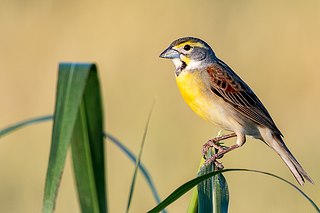
Cardinalidae is a family of New World-endemic passerine birds that consists of cardinals, grosbeaks, and buntings. It also includes several other genera such as the tanager-like Piranga and the warbler-like Granatellus. Membership of this family is not easily defined by a single or even a set of physical characteristics, but instead by molecular work. Among songbirds, they range from average-sized to relatively large, and have stout features, some species with large, heavy bills.
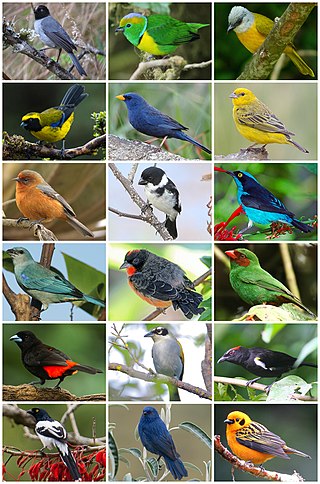
The tanagers comprise the bird family Thraupidae, in the order Passeriformes. The family has a Neotropical distribution and is the second-largest family of birds. It represents about 4% of all avian species and 12% of the Neotropical birds.

The typical honeycreepers form a genus Cyanerpes of small birds in the tanager family Thraupidae. They are found in the tropical New World from Mexico south to Brazil. They occur in the forest canopy, and, as the name implies, they are specialist nectar feeders with long curved bills.

The red-crowned ant tanager is a medium-sized passerine bird from tropical America. It is the only species now placed in the genus Habia. This species was long placed with the tanagers (Thraupidae), but it is actually closer to the cardinals (Cardinalidae).

Saltator is a genus of passerine birds in the tanager family Thraupidae that are found in Central and South America. They have thick bills, relatively long tails and strong legs and feet. Before the introduction of molecular genetic methods in the 21st century these species were placed in the cardinal family Cardinalidae.

The red-throated ant tanager is a medium-sized passerine bird. This species is a resident breeder on the Caribbean slopes from southeastern Mexico to eastern Panama. It was formerly placed with the red-crowned ant tanager in the genus Habia. It was usually considered an aberrant kind of tanager and placed in the Thraupidae, but is actually closer to the cardinals (Cardinalidae). Consequently, it can be argued that referring to the members of this genus as ant tanagers is misleading, but no other common name has gained usage.

The hepatic tanager is a medium-sized American songbird. Formerly placed in the tanager family (Thraupidae), it and other members of the genus Piranga are now classified in the cardinal family (Cardinalidae).

The chestnut-headed tanager is a species of bird in the tanager family Thraupidae this is found in the Atlantic Forest of southeast Brazil, eastern Paraguay and far northeastern Argentina. It was formerly the only member of the genus Pyrrhocoma but is now placed in Thlypopsis.

The yellow-shouldered grosbeak is a species of bird in the tanager family Thraupidae. It is the only member of its genus Parkerthraustes. It is found in Bolivia, Brazil, Colombia, Ecuador, and Peru. Its natural habitat is subtropical or tropical moist lowland forests.
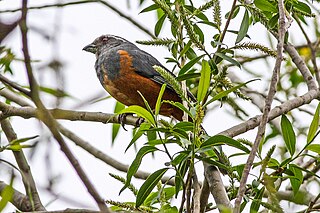
The rufous-bellied mountain tanager or rufous-bellied saltator is a species of songbird in the tanager family Thraupidae and is the only member of the genus Pseudosaltator. It is found in the eastern Andes of southern Bolivia and extreme northern Argentina. It occurs mostly at altitudes from 3000 m to 4000 m. Its habitat is open land, including cultivated land, that has patches of scrub, alder trees, or Polylepis trees. It is threatened by habitat loss.

The masked mountain tanager is a vulnerable species of bird in the tanager family Thraupidae. It is the only member of the genus Tephrophilus. This large and colourful tanager is endemic to elfin forest, woodland and shrub in the Andean highlands of southern Colombia, Ecuador and northern Peru. It is generally rare or uncommon, and is threatened by habitat loss.

Carmiol's tanager is a species of bird in the cardinal family Cardinalidae that is found in Central America from Nicaragua southwards to northwest Colombia. Its natural habitats are subtropical or tropical moist lowland forests and heavily degraded former forest. It was formerly considered as conspecific with the yellow-lored tanager.

Chlorothraupis is a genus of bird in the family Cardinalidae. It was long considered to be a member of the tanager family (Thraupidae), as their common names suggest, but this is false. They are close relatives of the genus Habia, the "ant-tanagers".
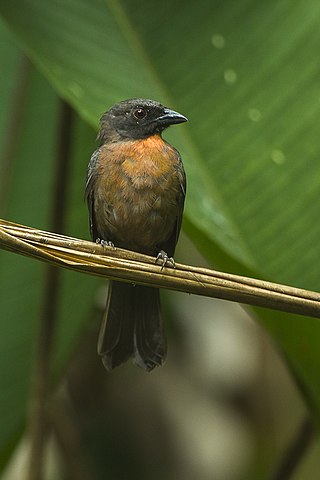
The black-cheeked ant tanager is a species of bird in the family Cardinalidae. It is endemic to Costa Rica. It was formerly placed with the red-crowned ant tanager in the genus Habia.

The crested ant tanager is a bird in the family Cardinalidae that is endemic to Colombia. It was formerly placed with the red-crowned ant tanager in the genus Habia.

The sooty ant tanager is a species of bird in the cardinal family (Cardinalidae). It was formerly placed with the true tanagers in the family Thraupidae and was assigned to the genus Habia with the red-crowned ant tanager.
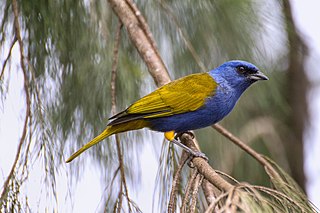
The blue-capped tanager is a species of bird in the tanager family Thraupidae. It was formerly placed in the genus Thraupis but is now the only species in the genus Sporathraupis.
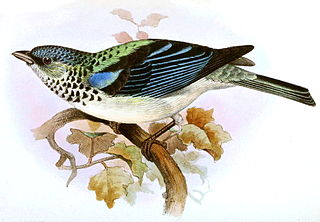
Poecilostreptus is a genus of birds in the tanager family Thraupidae.

Asemospiza is a genus of South American birds in the tanager family Thraupidae.



















